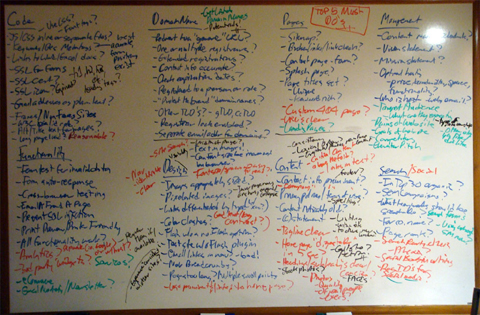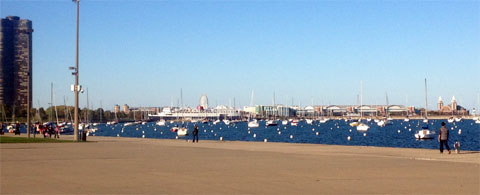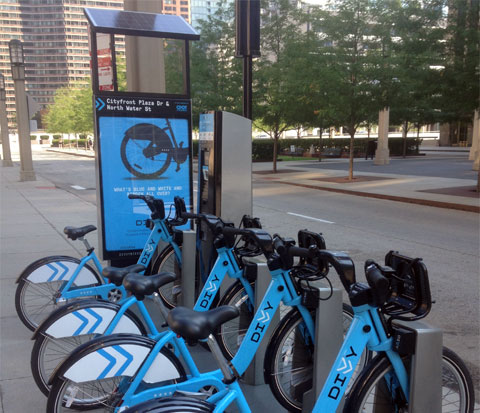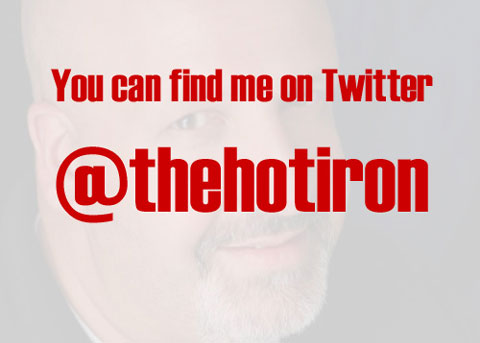How I Took An Idea And Made It A Reality
 With all the ideas and events swirling through the Windy City during the recent Chicago Ideas Week, one of those thoughts was what I would like to share here, how I took an idea I had and made it a reality. Though this story took place a few years back, it is still very vivid in my mind.
With all the ideas and events swirling through the Windy City during the recent Chicago Ideas Week, one of those thoughts was what I would like to share here, how I took an idea I had and made it a reality. Though this story took place a few years back, it is still very vivid in my mind.
My idea was to create a piece of marketing collateral for my Web consulting business. In this case, I could leave it would a prospect client, allow it to be downloaded from the Web and simply put it out there in printed format, the last 2 cases would be for anyone who wanted it. Depending on where the prospect was, it could server anywhere from a calling card, functional tool or a call to action to contact me.
Origin of the Idea
In my Web consulting business there were 2 categories for prospects – those who did not have a Web site and those who had one and were looking to possibly redesign and/or rebuild it. Where there were many common elements between the 2 for the sales process, when talking with someone who already had a Web site there was always a level of ambiguity to what exactly they needed or wanted to do and to what extent.
To try to streamline this process in a non-intimidating way, I thought of a form of checklist, where someone could read off the list to see if they had any or all of the items incorporated into their Web site, or at least to pose the questions in the event they didn’t know. In my mind’s eye I had a partial vision of the checklist. I saw it as paper-based, as likely someone would read a question from it then look on their Web site on their computer’s monitor for the answer. I wasn’t sure if there should be a score of some form or not. I was very sure I did not want it to be too technical and I did want it targeted to the business owner.
As for what would be in the checklist I had some ideas, but this was something I wanted to put time into over a period of time, then organize them into the checklist.
Like Rodney Dangerfield’s Joke Bag
The process of collecting the items for the checklist had me recalling a story I once heard about the late-great comedian Rodney Dangerfield. Before he got into comedy, he was a salesman and would write jokes on pieces of paper and put them into a duffle bag. When the bag was full, he had the material he would use on stage.
My approach was similar, yet different, as my duffle bag was digital – consisting of folders on my hard drive and in my email program. The ideas I captured varied from text files to links to other Web sites to email newsletters, where some of these items were direct ideas and others either categories or thoughts. I let this collection come together over a period time (exactly how long I do not remember). Then one day I decided to start the process to build the checklist.
Molding the Ideas into the Finished Product
As the collection process had elapsed some time and I didn’t remember everything I had put together, I decided I would go through them, one-by-one and begin curating a list. This was facilitated with the help of my whiteboard. As I read an item, I checked if it I already had it on the board, and if not I added it in some semblance of order. When all was done, this is what my whiteboard looked like:

At first glance, it is a mess. But it was the first pass at the organization of the items and ideas. Needless to say it was worthy of a picture!
From here, I started typing up the ideas, and in some cases I would combine like or similar ones. As I typed them up, I erased them from the whiteboard. At the end of this process hundreds of files and emails were in a clean list, just as clean as the whiteboard now was.
The next step was to boil the list down to a manageable, 1-page list, with the top, most important items on it. This was done over several days, as I would look at the list for a while, then revisit it later with a fresh brain. In the end, I finalized a list of 34 items and broke them down into 3 categories – business, content and design. I also came up with some copy to describe the checklist to put on the reverse side of it. At this point I felt really good about the checklist. Well, except for the name of it.
(Queen’s) Landing on the Right Name

The original name I had for the check was, and get ready for it:
The Web Site Redesign Self-Assessment Checklist
Yes, it sucked. Here I spent all of this time and produced what I felt was a quality product, yet the name would surely be a turn-off, and in some cases scare off people. I decided to put the completed checklist aside as I needed some more quality time to get the name right.
On a Friday evening after work, I went for a walk along Lake Michigan. Armed with a good cigar, I just needed to clear my head after a busy week and stretch my legs. As I was strolling by Belmont Harbor, the topic of the checklist name came front in center in my head. I recall shaking said head and saying to myself, “why don’t I have a better title for this” and the gears in my head started to crank.
As I headed south along the lakefront path, I started decomposing the goal of the checklist. The thought process went something like, “it’s where your Web site is now… it’s a point in time… it’s the current state your Web site is in… wait, that’s it – it’s the State of your Web Site!”
I stopped where I was, at a place along the lake called Queen’s Landing and called my office line and left myself a voicemail message on the name so I wouldn’t forget my inspiration. When I got back from my walk I edited the Word document with the name and then registered the domain name for it.
The State of the State Then and Now
Upon completing the checklist I setup a download page for it and promoted it here on The Hot Iron and elsewhere. I printed copies of it to give people in person and to bring to events as a leave-behind. Although the list never was mentioned on the cover of the Wall Street Journal, it would get a handful of downloads each week and I got good feedback on it from prospect clients and current clients as well.
Now almost 3 years after I created the checklist, it needs to be updated a bit, which would come probably after a new brainstorming session on it. That being said, there are many core concepts on the checklist that are still very relevant today as-is.
See for yourself – download a copy of The State of Your Web Site here right now!
Ideas, Visited
Ideas are just that, intangible thoughts. Without any action, they will remain in that state, floating out there. I know, as The Hot Iron is full of ideas I have had over the years. Where I have acted on many of ideas over the years, I am very proud of the creative process I have just shared here.
Your thoughts – and ideas – on the checklist and the process which led to it are welcome in the comments.
Editor's Note: This post was updated to correct and replace broken links.
This is from The Hot Iron, a journal on business and technology by Mike Maddaloni.
Did you enjoy this? Subscribe to The Hot Iron by RSS/XML feed or Read by Email
Build • Business • Strategize • Technology • The State of Your Web Site • Thrive • Web Design • Web Development • (0) Comments • PermalinkFlying Over Chicago and Milwaukee With The Nokia Lumia 925
Following the receipt of the loaner Nokia Lumia 925 mobile device from Nokia Connects and capturing its unboxing and first impressions on video, I now had the opportunity to use it. Where I don’t have a SIM card to use it as a phone, I was only able to use it as a WiFi-enabled device. And despite the chance to use a Windows Phone device for the first time, time was not on my side.
Except for a few hours last Sunday, when I took the Lumia 925 with me at about a couple thousand feet over the US Midwest. My friend Walter is a pilot and offered to take me up with him for a flight. Last Sunday was a clear and cool day in the Chicagoland area, so it was perfect for flying. Departing from the airport in Aurora, Illinois, which is west of Chicago, we flew east over Chicago then headed north to Milwaukee, Wisconsin, and then back south to Chicago and west back to Aurora.

During the flight I took almost 200 pictures and a half dozen videos. Where some of the photos were duplicates of just bad shots, just over 150 of them came out pretty good and I offer you a slideshow of the photos on Flickr, and a playlist of the videos on YouTube – embedded below are links to both.
View the photos below or link to the photos here.
View the videos below or link to the videos here.
Thoughts on the Lumia 925 while taking pictures
Overall, I liked the experience of using the Lumia 925 as a camera. The only features of the camera I used was the zoom and shutter – I did not use or play with any other features, namely as I am simply a point-and-shoot guy, so I would rather manipulate a photo on my PC in PhotoShop than on my device. The best feature to me was the transition when a picture is taken, which is much clearer than the camera “upgrade” with iOS7 for the iPhone. The zoom feature of the camera took somewhat blurry pictures. Now I did not use the camera much at all on terra firma, so I don’t know how the zoom would be on fixed objects. The final thing I missed in the Lumia 925 was the holes for a lanyard or wrist strap, which would have made taking some shots easier.
As for some of the pictures being hazy, these photos were taken between 10 am and noon, and in some cases the sun was not behind me and rather to the side or right in front of me. That tells the difference in the photos of the Chicago skyline as we flew over the city and those when looking north after passing the city, which came out amazingly clear as the sun was behind me.
Thanks Walter!
Thanks again to my friend Walter for taking me up on an amazing tour of the area from an awesome vantage point. I welcome your thoughts on the pictures and videos and you can leave them in the comments of this post.
As a final comment, I am returning the Lumia 925 to Nokia Connects as my 2-week evaluation period is over. Nokia lent me the device with no cost or expectation of how I used it, nor did they ask me to take it in an airplane…
This is from The Hot Iron, a journal on business and technology by Mike Maddaloni.
Did you enjoy this? Subscribe to The Hot Iron by RSS/XML feed or Read by Email.
Mobile Technology • Technology • Thrive • (0) Comments • Permalink
Nokia Lumia 925 Unboxing and First Impressions
It’s been a while since I have evaluated a mobile device. As a matter of fact, it has been just over 2 years since I had a loaner Nokia E6 from Nokia Connects. My, how times have changed! Today Nokia’s mobile division is all about Windows Phone, and not to forget soon will be part of Microsoft. So I felt it was time to reconnect with the Nokia crew and they have lent me a Nokia Lumia 925 to evaluate.
View the unboxing of the Nokia Lumia 925 below or on YouTube directly.
As you may have noticed, I am new to the Windows Phone ecosystem, and what is the first thing I do? I deleted an icon! Hopefully my experience will get better as I learn my way around the device over the next couple of weeks, especially using the Carl Zeiss lens on the PureView camera.
Let me know if there’s anything in particular you would like me to try on the 925, as well as any other thoughts on it, and you can add them to the comments to this post.
This is from The Hot Iron, a journal on business and technology by Mike Maddaloni.
Did you enjoy this? Subscribe to The Hot Iron by RSS/XML feed or Read by Email.
Build • Mobile Technology • Technology • (0) Comments • Permalink
Divvy Bike Sharing In Chicago Needs To Offer Helmets
Chicago is all about bicycles. From casual riders along Lake Michigan to people taking their bikes to work every day to everyone in between, there are bikes all over the streets and trails in the Windy City. This intensity has been raised in the past few months since the Divvy bike sharing program has started.

Take a look at this picture and see if you can see – or not see – what I don’t see. This gave me my idea. With additional inspiration from a recent safety video contest that Divvy ran, as well as the upcoming Chicago Ideas Week, I’d like to share and detail my idea for the Divvy program.
First What is Divvy?
Divvy is a service owned by the City of Chicago and run by a commercial third-party company that offers similar services in other cities. The idea of bike sharing is for taking short bike trips around the city, where you rent a bike from one bike station location, as pictured above, and return it to another. The keyword is “short” as you have 30 minutes to go from one bike station to another. You can pay US$7 per day to use a bike for unlimited 30 minute trips, or you can also buy an annual pass to use the service daily.
The bikes themselves are also custom designed, 1-speed bikes with lights powered by pedaling and more rugged than a standard personal bike. The front wheel locks to the station until it is rented. The seat is adjustable and there is a front rack for carrying items. All bikes have fenders covering both tires to keep you drier in the rain, and are light blue, matching the color in the Chicago flag (with the exception of the one red bike).
Divvy Bikes Are (Almost) Everywhere
Since their rollout, barely a block goes by without the sight of a Divvy bike in motion. Though the intended market for the service is city residents, tourists have been renting them as well. The tourist element may not have been anticipated as there have always been options to rent bikes, carriers and even get helmets from the rental shop. For as bike friendly as Chicago is, bikes are often playing a dangerous game with cars for the same street real estate throughout the city. Where marked bike lanes and even some with dividers exist, they are not everywhere, and many say not as much as are needed.
As you may have guessed by now, there is one thing missing from the Divvy bike program – bike helmets.
Divvy just rents bikes, it is up to the rider to get their own helmet, as is stated in the user agreement on their Web site. However, there are not many retail locations in the city where you can buy helmets. With the launch of a social media video safety campaign the lack of a helmet offering represents a huge missed opportunity.
What Would Have Been My Entry In The Divvy Safety Contest
This would have been my submission for the Divvy safety video contest, a 6-second video I created with Vine. Had I gotten to this earlier, I would have submitted it, but alas I missed the deadline. It’s embedded below, or follow this link to view my Divvy bike helmet video on Vine’s Web site.
Some Realities Of Helmets
Before I get into details on the offering of helmets, a little setup first. There is no law in Chicago or Illinois mandating the wearing of bike helmets, and I am not advocating one. Personally when I ride a bike, I always wear a helmet, especially as I once flipped my bike and I was glad I was wearing one! As one who believes in helmets, coupled with the Divvy user agreement stating you should wear one, there is an economic opportunity being missed by not offering them, not to mention the potential safety issues with tourists who may not know where they are going meandering the streets of Chicago.
If you look at the above photo and video again, you will see the Divvy bike stations are designed to dispense bikes, and not helmets, which poses its first challenge. Another challenge comes with the various sizes of helmets needed, as a helmet should fit snug on your head to be effective. Finally, if you are going to reuse a helmet it should be disinfected (think bowling shoes!) or each person would get a new, unused helmet.
Challenges as they may be, I see a couple of approaches to handling – or plain out selling – helmets, both in the short term and long term for the Divvy program.
People-Powered Sales
You don’t have to go far in Chicago without someone trying to sell you something. From the legitimate sales of newspapers and the Streetwise magazine (which I had a previous idea on, but I digress) to people hawking water, self-made CDs or pure panhandling. Why not have people sell helmets direct to riders as select Divvy stations?
The setup for selling helmets can be simple – wheeled duffle bags full of varying sized helmets, mobile devices with Square-like credit card swiping done by a person wearing a Divvy shirt. If sales of helmets are brisk, inventory can be replenished by the already on-the-road Divvy vans which are restocking bikes at certain stations.
Innovation For The Long Term
You may have seen vending machines selling electronics or other items at airports, train stations and even rest stops on highways. There is even an “ATM” in Chicago that vends cupcakes!

Why not a vending machine selling helmets, integrated into each Divvy bike station?
As Divvy bikes and the stations were engineered for their use, so would the bike helmets and the vending machine. I envision a unique helmet designed so a large quantity of them can be stored in a vending machine. The helmets may also be designed to be adjustable so that fewer sizes are needed? I don’t know the answer to how this would work, but I bet there is an engineer who could figure it out. The vending machine itself would be designed to not take up much space and integrate with the current purchasing function of the station.
Beyond The Helmet
As the typical cost of buying a helmet is more than the cost of a daily rental of a Divvy bike, marketing and sponsorship opportunities could decrease the cost of helmets. Would Nike or Groupon or PNC Bank pay money to put their logo on what is in essence a traveling billboard around the streets of Chicago?
And while they’re at it, where are the ads on the bikes themselves? It would certainly contribute to what is in essence a taxpayer-funded program.
Take My Idea Please!
Though Divvy is still a few months old, it has great popularity and exposure. My idea isn’t the only one out there for the service – this story is on an app created by a Chicago resident for logging miles, but was taken down as it violated the Divvy terms of service. Of course if Divvy made available – or even sold – data or the capacity to access it via an API, then there could be even more innovation and potential revenue.
As I myself am in no position or have the time to act on this idea, go ahead and take it and run with it. All I ask in return is a pat on the back and maybe the first helmet off the assembly line.
I also welcome your feedback – and ideas – in the comments of this post.
This is from The Hot Iron, a journal on business and technology by Mike Maddaloni.
Did you enjoy this? Subscribe to The Hot Iron by RSS/XML feed or Read by Email.
Business • Strategize • Technology • (1) Comments • Permalink
Why I Quit Facebook
Nine months ago I did something that, looking back now, was both a brilliant and educational moment in my life.
No, not “that!” Instead, I quit Facebook.

What did you say Mike, quit “the” social network” Yes, I did. I had thought about it for a while, and when I heard of other smart people I know also getting out of the closed ecosystem like my good friends Jen Hanen and CT Moore, I decided it was time for me to stop the madness myself.
And you read that correctly – I had been thinking about quitting Facebook for a while. Why? The reasons below are many. Blended together, they got me to cancel once and for all.
Nothing Personal
Quitting Facebook had nothing to do with any specific person, people or event. I did not do it in retaliation to anyone for any specific act. Rather, my decision was based on trends around how and what people communicate, actions that were moving in a direction by just about everyone who was using Facebook that I was connected with (and others who were friends of friends) that I did not like. I also count myself in with that grouping of people.
Even though I had amassed quite a large group of “friends” over the years, the quality of communications was not there, only the mass quantity of it. The fact I disconnected from them on Facebook doesn’t mean that I don’t like them, it was the pool we were all swimming in that I didn’t want to be in.
Too Much Information All The Time
Social media is all about sharing. But when everyone is sharing as much as they are, all the time, it can get overwhelming. I was getting drawn into Facebook and was spending too much time separating the wheat from the shaft to find relevant or useful information or engage in somewhat meaningful conversation. A visit to Facebook.com or the app on my mobile device was a time suck, as I was compelled to keep scrolling through until I found something of interest, even though many times I didn’t.
What I was sorting through was another matter altogether. They say that kids say the darnest things, well adults on Facebook are even worse. Just when I thought I had seen and read it all, I would read more and more detail that one wouldn’t normally post to the world, let along share in a whisper. Yet there it is, posted for all to see on Facebook.
One Hot UX Mess
To make matters worse, when Facebook went to the 2-column format, it became far too much for me. It was completely unusable, and compound that with the aforementioned volume of content and it makes for something I found very difficult to read and enjoy. Why subject myself to a (user) experience I did not like? I don’t visit some Web sites because of design and functionality flaws, so why should Facebook be any different.
One thing positive I will say about Facebook is the powerful engine behind that user experience. How often do you get a real error on Facebook? Years ago I attended a local conference and some developers from Facebook were there talking about the architecture of the site, and afterwards I had the opportunity to talk with them one-on-one. I was extremely impressed with their background, experience and the technology behind the site. How it was presented, at least to me, did not live up to what was powering it.
Living McLuhan’s Words
To me, Facebook lived to the letter of the words of Marshall McLuhan in that “the medium is the message.” I had written about this a couple of years ago in a post here on the Hot Iron titled Streaming Awareness By how I lamented about missing the birth of friends’ kids that were only announced over social media, and I never saw the original post. Needless to say, it continued. There were more I missed, though each time I did bring it to the parents’ attention my dismay – once it even compelled someone to send old-fashioned birth announcements by postal mail!
This changing of how we communicate feels almost like a cheapening of the interaction between people. Miss a small couple of word post on someone’s wall and you could miss out on seeing someone visiting town, and then the person who posted those few words thinks you are ignoring them. Yes, that happened to me once. Now I am not saying we all need to grab our quill pens, ink reservoirs and parchment paper and write long letters. Any tool of communication can be used wisely or poorly. Where changing your relationship status to “single” can inform the world of a divorce or major break-up, there are certainly classier, more tasteful ways to do so.
There was at least one time when Facebook put in a chance to only display the posts of people you recently communicated with. Huh? Yes, so if I was communicating a lot with 20 people, I would predominantly see the posts from them, and anyone else I may not see at all. When I heard about this I was shocked and undid the setting, and low and behold I was hearing from everybody, as I should be. It’s one thing if I make such a setting change, but I certainly don’t want someone telling me what I read and do not read.
And Now A Word From Our Investors
I will certainly not say that I predicted the snooping and tapping of electronic messaging on networks and social media sites by the US government. When I read the article in Time magazine when Mark Zuckerberg was named Person of the year in 2010, there is a direct mention about US FBI Director Robert Mueller walking in on the interview -. Why was the FBI Director at Facebook headquarters? I’ll leave it at that – read the article for yourself.
Nobody Seemed To Notice
Over the last 9 months, I have only heard from 3 people who said they tried to reach me on Facebook but could not find me. There were some that I told about my decision, and I certainly mentioned it more than once on Twitter. I had changed my Facebook picture and banner to the image at the top of this post, but once thing I did not do was inform people through Facebook that I was going to quit. Why? More so out of curiosity if anyone would realize I was no longer in their “stream” of consciousness. This experiment in social media was correct, but sad in its own right.
Don’t Call Me Anti-Social (Media)
Though I am not on Facebook, I am not shying away from social media. I am on Twitter @thehotiron, and this blog is my primary channel for longer form writing, longer than 140 characters anyway.
I have been drawn to Twitter because of its simplicity and binary nature – what I put out there is out there, and what I send as a direct message, which I use infrequently, is not. I find it easy to have conversations with individuals and on occasion with groups, though I don’t often participate in Twitter chats which are commonly driven by a unique hashtag. I also find it easy to pickup on a conversation and continue it later with the medium. My Twitter client of choice is HootSuite on the PC, though I am using the Twitter.com Web interface more and more as it has evolved tremendously. Twitter for me is like the water cooler or barstool in the local pub.
Blogging is something I enjoy and don’t do nearly as much as I used to and not as much as I would like to. In one regard it is an outlet for the things in my head, and in another it is a way to share and start a conversation. Where my tweets tend to be forgotten over time, my blog posts are still out there, and older ones still draw comments (even real, legit ones too!) and are shared by others. The Hot Iron is like a fireside chat or sitting down with a scotch and cigar among friends.
Looking Ahead And Always Evaluating
Facebook is not the only game in town. If you quit Facebook it should not be the end of your social media activity or identity. I have written before here at The Hot Iron about managing your online presence and I will continue to do so. But at the end of the day, what you do online should be only a part of who you are. So whether you call, tweet or write longhand, you are greater than the tools you use to communicate.
Your comments, as always, are welcome and encouraged!
This is from The Hot Iron, a journal on business and technology by Mike Maddaloni.
Did you enjoy this? Subscribe to The Hot Iron by RSS/XML feed or Read by Email.
Blogging • Social Media • Technology • Thrive • (4) Comments • Permalink



